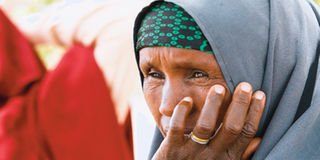Somali refugees deserve better than being sent back to danger

A newly arrived Somali refugee awaits registration outside Dadaab. Many refugees survive on little or no water or food while they journey to Dadaab from neighbouring Somalia. PHOTO|FILE
What you need to know:
- Dr Karanja Kibicho, the principal secretary for the Interior, claims that the refugee camps pose a security risk to Kenya and that the Westgate mall and other terrorist attacks in Kenya were planned at the Dadaab camp.
The reasons the Kenyan government has given for its sudden decision to close down the Dadaab and Kakuma refugee camps, which are home to some 600,000 refugees, mostly from Somalia, South Sudan, and other neighbouring countries, are not only baseless but smack of xenophobia and scapegoating.
Dr Karanja Kibicho, the principal secretary for the Interior, claims that the refugee camps pose a security risk to Kenya and that the Westgate mall and other terrorist attacks in Kenya were planned at the Dadaab camp.
This claim is unfounded as none of the Westgate terrorists were identified as being from Dadaab. In fact, some of the terrorists named in the more recent attacks were not even Somalis but Kenyans.
The principal secretary insists that the refugees will be safe when they return to Somalia because the Kenya Defence Forces “have liberated large swaths of Somalia from the hold of Al-Shabaab” and that even “UN workers traverse much of that liberated country with relative safety”.
What he does not explain is why Kenyan and African Union forces are still in Somalia if the country has returned to normality or why the staff of the UN and other international organisations still travel in armoured cars and are not allowed to leave the relatively safe Green Zone near the airport in Mogadishu.
The only place in Somalia that could be considered safe is the self-declared independent state of Somaliland, where there are no Kenyan forces present and which is not likely to take in the refugees.
The government says that the camps are neglected due to a shortfall in aid. This may be true now, but a major humanitarian summit is scheduled to take place in Istanbul next week when the international community will make a case for more support and aid for refugees.
Why withdraw support for refugees when there is goodwill globally to do more for people fleeing from conflict?
Besides, Kenya has always been credited for its humane, open-door policy towards refugees and for not flouting international laws that protect people seeking asylum. Why would it want to be among those rogue countries that turn away refugees? What political mileage can the country gain by adopting such a stance?
Why has the government decided now to breach the principle of non-refoulement, which protects refugees from being returned to places where their lives could be threatened?
One of the factors the government has not taken into consideration is that refugees can actually be good for the economy. It is estimated that Dadaab’s economy generates about $25 million a year and that the local host community around the camp earns about $14 million a year in trade and contracts.
While living conditions are difficult for most of the refugees in this “City of Thorns”, as British writer Ben Rawlence has called Dadaab, many of the refugees have demonstrated immense resilience and entrepreneurship.
The Department of Refugee Affairs, which the government is threatening to close down, has even referred to Dadaab as “a big business centre”.
However, restrictions on movement make it difficult for the refugees to move out of the camp and establish a financially independent existence.
The government does not allow the refugees to build permanent structures, which means that they are condemned to living in shacks built with mud, sticks, and plastic sheeting donated by the UN’s refugee agency.
The lucky ones obtain residency rights in third countries such as Australia and Canada, but the option of obtaining Kenyan residency rights is not available to the majority.
(Could it be that, given the antagonistic attitude of the Kenyan State towards ethnic Somalis since independence, the government is afraid to give residency rights or citizenship to large numbers of Somalis as this may shift the ethnic “tyranny of numbers”?)
People who were born in or who have lived in a refugee camp for 25 years cannot suddenly be expected to go to a country they barely know or remember.
The most humane option would be to give them citizenship. This is what Tanzania did with its Burundian refugees.
With the right to live and work in Kenya, the former refugees will no longer be dependent on handouts and their dignity will be restored. And, who knows, Dadaab and Kakuma could transform into thriving cities.
Rasna Warah is an analyst and commentator based in Nairobi. [email protected]




